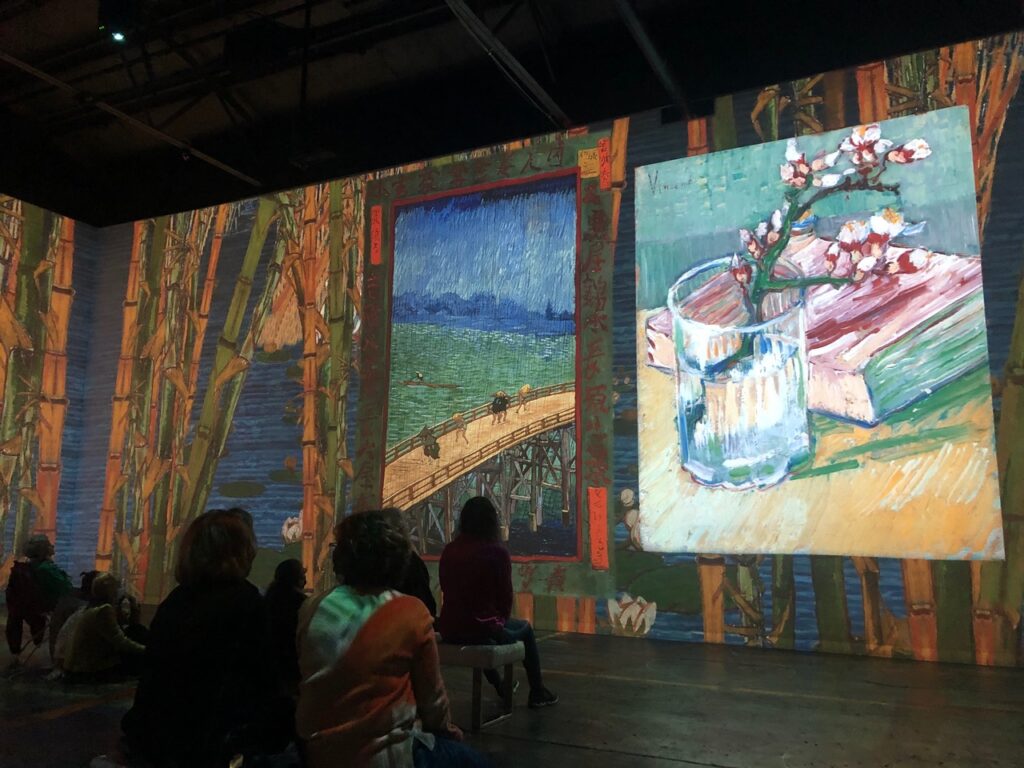
When my husband first mentioned it, I wasn’t sure I wanted to go to the Immersive Exhibit of artist Van Gogh’s oeuvre, “body of work” when it visited Pittsburgh. Conceived and designed by creative director and Italian film producer Massimiliano Siccardi, with soundtrack by Italian visual artist and composer Luca Longobardi, the show began in France and is currently traveling to major cities around the globe. The PR experts promise “500,000 cubic feet of monumental projections,” a 360-degree immersion, that will “truly illuminate the mind of the genius.”
This may be the time to point out that Van Gogh, the artist known for vivid colored landscapes and brightly beaming stars suffered from mental illness most of the years he was painting. He moved in and out of sanitariums throughout his young adult life, dying from a self-inflicted gunshot wound, unknown, and broke at the age of 37. It’s not a mind I’ve ever thought I would like to climb inside of. “I’m afraid it will be too overstimulating,” a friend from my generation suggested. I admitted to the same fear but decided, “I can do this, and who knows, it just might be worth it.”
In addition to his 900 paintings and additional drawings, Van Gogh’s writings to his brother were prolific and are available to us. A statement he made about making his art is the same thing I would say about attending the art exhibit. “The beginning is perhaps more difficult than anything else, but keep heart, it will turn out all right.” I found it incredibly disorienting and scary to enter the large exhibit space in the dark, not seeing where I was putting my feet. I couldn’t be sure where my body was in space, and the friend who accompanied me and I got separated immediately. Once we found each other and a bench to sit on, it did turn out all right; the light, music, and imaginative movement pulled us in and washed over us in a manner reminiscent of Raves or art exhibit dance “Happenings” of my youth. I felt deeply moved by the experience, by the integration and repetition of images accompanied by music. It made possible a kind of embodying of the images that sent my mind free, as what happens in a movement meditation. I’m certain that this exhibit is only the first of such efforts to bring together projections of art images and music and I’m curious to see where this will go.
The concept of co-destiny in grief theory came to me. When a young person dies with more left to do in their life, a parent or loved one steps in to carry on their mission and their message. It could involve donating a scholarship in their name or taking up the tasks of their unfinished life work. Family members and friends did that for Van Gogh, believing in and promoting his work after his untimely death, or none of us would know his name. And these 21st century artists are promoting and developing his work in ways he would never have been able to imagine.
As an expressive arts therapist Van Gogh’s life and work hold another fascination for me. I agree with a quote attributed to him, “Art is to console those who are broken by life.” I like to believe that his art did that for him to the extent that it could, and that it can do that for us as well.

